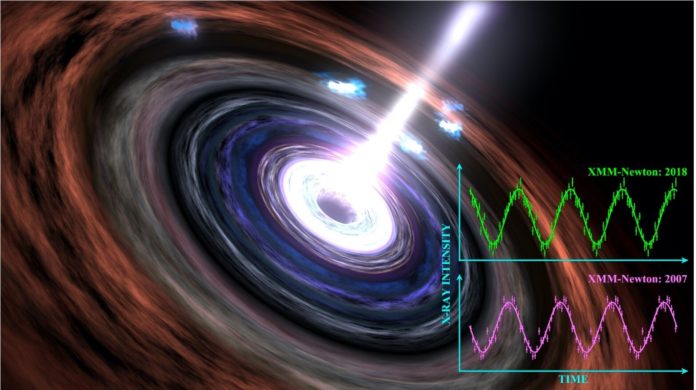In 2007, scientists detected a black hole’s heartbeat at the center of a galaxy called RE J1034+396. The universe is almost 600 million light-years from Earth.
Scientists detected that the signal from this galactic giant repeated every hour.
Later on, in 2018, the European Space Agency’s XMM-Newton X-ray satellite reobserved the black hole. It identified that the repeated heartbeat could still be seen.
A new study based on all the XMM–Newton observations of RE J1034+396 obtained in 2018, confirmed that the black hole’s heart is still beating. This is the most long-lived heartbeat ever seen in a black hole.
X-ray satellite observations spotted the repeated beat after its signal had been blocked by our Sun for several years. The study could provide detailed insights on the size and structure close to its event horizon—the space around a black hole from which nothing, including light, can escape.
Professor Chris Done, in Durham University’s Centre for Extragalactic Astronomy, said, “Matter falling on to a supermassive black hole as it feeds from the accretion disc of material surrounding it releases an enormous amount of power from a comparatively tiny region of space, but this is rarely seen as a specific repeatable pattern like a heartbeat.”
“The time between beats can tell us about the size and structure of the matter close to the black hole’s event horizon.”
“The main idea for how this heartbeat is formed is that the inner parts of the accretion disc are expanding and contracting.”
“The only other system we know which seems to do the same thing is a 100,000 times smaller stellar-mass black hole in our Milky Way, fed by a binary companion star, with correspondingly smaller luminosities and timescales.”
“This shows us those simple scalings with black hole mass work even for the rarest types of behavior.”
No matter what, This heartbeat is fantastic! It offers evidence that signals arising from a supermassive black hole can be powerful and persistent. It also challenges scientists further to investigate the nature and origin of this heartbeat signal.
Scientists are further planning to execute a comprehensive analysis of this intriguing signal. They will then compare it with the behavior of stellar-mass black holes in our Milky Way.
The research is done by the National Astronomical Observatories, Chinese Academy of Sciences, China, and Durham University, UK.
Journal Reference:
- Chichuan Jin, Reobserving the NLS1 galaxy RE J1034+396 – I. The long-term, recurrent X-ray QPO with a high significance. DOI: 10.1093/mnras/staa1356
